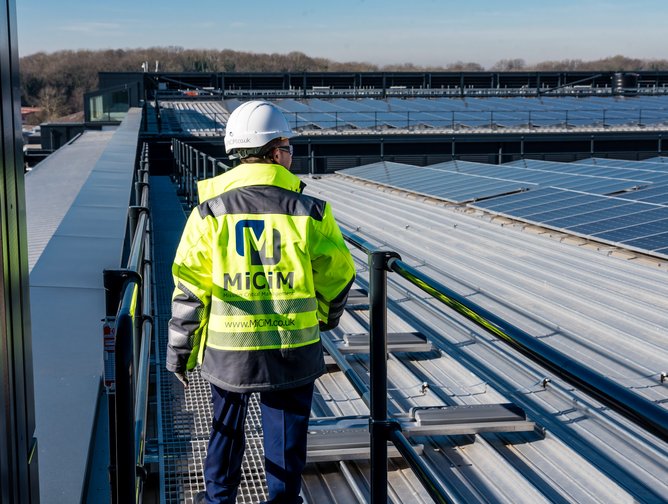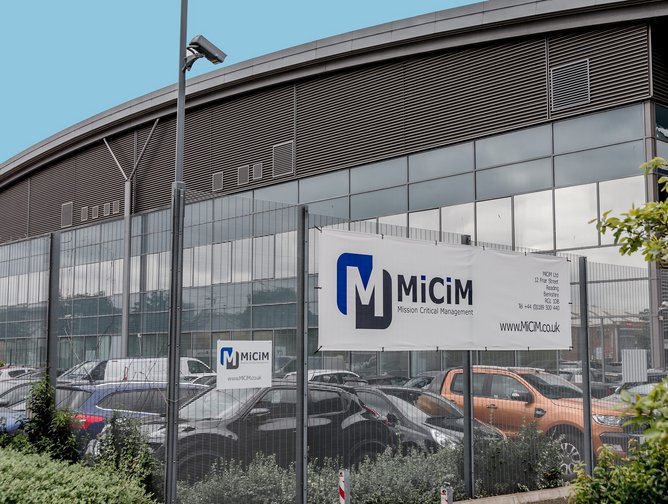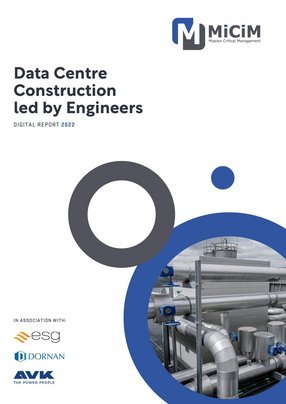Managing Director Marc Beattie, Construction Director Chris Jarman, and Commercial Director Daniel Potter founded MiCiM Ltd in 2016. At the time they were working on a data centre in the UK for a well-known major construction company, but began looking for alternatives as their UK data centre work was coming to an end.
Beattie, Jarman, and Potter knew they wanted to set up a business focused within the data centre sector and considered several DC service-oriented entry options before settling on data centre construction within MiCiM.
“In the end, we decided to just go and do what we know best and build data centres,” said Beattie.
They entered the market and approached Richard Herrington, a former Director of their previous company, who agreed to join them and MiCiM was born.
“We were very open with our previous employer about what we were doing and they wished us well. We looked at our client base, talked to them and advised them what we were doing,” said Beattie.
In the beginning, Beattie and the team were looking to build “everything they could'' but later realised this would be difficult as the business was new and as a result would not pass the required financial checks. This saw its operations shift more towards Project Management, and they soon secured an opportunity with Gyron. Subsequently, after some hard work and initial success on a project, more appointments were negotiated and the company doubled in size after 6 months. The next stage of growth occurred shortly after MiCiM’s one year anniversary when Gyron asked Beattie and his team to manage the construction of its next project – a hyperscale data centre called NTT Dagenham. According to Beattie, the new opportunity increased MiCiM’s staff by another five or six, and the company continued its growth.
“We received further calls from a well-known Singaporean client whom we went over to help finish a project in Dublin, and that led to a construction management role on a hyperscale data centre that we're working on now,” said Beattie. “We were also undertaking smaller construction projects and our reputation grew.”
This led the company to work with Cyxtera on a project in Slough, which it was able to complete quickly. “We won and delivered it in a very short time frame. It was 19 weeks for a 2.4-megawatt fit-out,” Beattie said. The company has subsequently negotiated the next phase with Cyxtera which they are currently working on.
The early successes, coupled with a growing reputation within the sector allowed MiCiM to expand the board 2 years ago with the appointment of Jeff Hunter as Engineering Director. Jeff completed the current board setup and has provided further impetus to drive us on to the next evolution of MiCiM.
The Construction Management process - MiCiM’s USP
With extensive experience in delivering projects using this form of contract, the construction management approach, part of MiCiM’s ISO accredited processes, allows the company to deliver its products on time, safely and economically. The programme, as well as commercial, design development, and commissioning processes are managed by an in-house team of experts. These processes are integrated by MiCiM into the client’s team.
The company also offers a hybrid integration service between Project and Construction Management, which involves MiCiM providing the client with pre-construction advice, procurement assistance and value engineering.
“I've been a great fan of construction management for a long time, since my days with Bovis who were one of the first companies to do it in the UK,” said Chairman Richard Herrington. “The philosophy is that, as opposed to being a contractor with an adversarial relationship with a client, you provide a professional support team, to work with the client as part of an integrated team to successfully deliver a project.
“The Construction Management approach to construction embraces the entire ethos of MiCiM and the philosophy under which we operate. In my experience of nearly 50 years in the construction industry the most successful projects are those where everyone is engaged with the same like-minded approach to solving problems and achieving the best outcome,” he added.
Herrington attributes the success of CM to a reliance on an “open and collaborative integrated teamwork approach from all parties to the project from the client down to the trade contractor’s operatives on site. In my experience that style of operation is rarely found under more traditional contracting models where the parties are by nature adversarial and protective of their own interests.
“In the current, fast-changing data centre market - mostly brought about by the development of technology and user demand in response to the growing demands of 5G, A.I, autonomous vehicles, video and music streaming, hybrid home working, online meetings, and online shopping - we are finding that clients who have always operated under a traditional fixed price contracting model such as JCT design and build are becoming increasingly dissatisfied with their project outcomes and are looking for new ways to approach projects.
“They are looking for alternatives which will give them a better degree of project control, more certainty of delivery, the ability to select the suppliers and contractors with whom they wish to work and to develop long term relationships”.
Technical Expertise and MiCiM Culture
MiCiM is an engineering, technically led business that has an enormous wealth of young and experienced talent in the business. Bolstered by the senior leadership's own experience and their very stringent recruitment process they’re able to hand pick the right candidates for the business needs.
Hunter said: ‘’Just being good technically is not enough. The attitude of our employees is the all-important differentiator for our business. He continues, “I am getting to the end of my career. I was taught by some really great people and now have a real passion to pass on my experience to others.” By creating the right environment and operating a real ‘no blame culture’ enables the company to highlight the passion, dedication and ambition exuded by the younger generation.
With this great attitude comes a continued need for self-improvement and at MiCiM we all strive hard to create an environment where anything is possible for everyone, and continued learning is actively encouraged.
To be achieve its business aims there are seven key areas that MiCiM has identified to focus on for its staff continual learning:
- Safety management
- Technical management
- Risk management
- Program management
- Quality management
- Package cost management
- Client stakeholder management
The Real Aim of this is to give the skills and understanding to ensure we create True Business leaders for the future!
MiCiM awareness about the current imbalance and lack of female representation within the industry and how the construction industry is perceived as a male dominated industry. Opened up a challenge for MiCiM to help to create more gender equality within the organisation with the hope that this extends to the entire industry in time. MiCiM have launched the Women in Construction Initiative curated by Lisa Taylor, Kerry Haynes, and Alison Newell. It’s fully supported by the MiCiM board of directors and championed by Managing Director, Marc Beattie.
Beattie says, “We want to support the ambition of creating gender equality within the construction industry and our commitment in doing so is at the core of our values.” MiCiM plans to achieve this by supporting, promoting and championing the women in their workplace, providing equal opportunities for all. MiCiM promotes a culture of inclusion, respect, opportunity and dignity, as part of their vision in becoming the employer of choice for females looking for a challenging and rewarding career in the construction industry.
Project protocols for efficiency
At the project commencement, MiCiM worked with its clients to develop a risk averse and efficient project protocols document. This is easily tailored between very large Campus CM projects to small internal fit out projects. It includes such items as document control and storage, project reporting, and record keeping. It is shared with all parties and is used to ensure the correct processes are being followed to achieve the desired outcomes.
With a very detailed knowledge of how to effectively manage projects. The MiCiM board from their collective experience recognises the need for efficiency in all aspects of project delivery. They have all worked on projects over the years experiencing firsthand the demoralising effect, time wasting and inefficiency by use of multiple incompatible systems.
In a drive for better efficiency and to add even more value they are currently actively developing a cloud based system with their software partners that will provide real time updates on every aspect of project delivery which will generate real time project reports giving all stakeholders total visibility of the project status in real time. MiCiM is part way through this process led by Sian Straw, MiCiM’s PMO Lead which they anticipate will be completed Q3 2022.
Sustainability, digital transformation, and modular design
From experience, MiCiM has proven that modelling reduces waste, time and improves quality all of which contributes to sustainability. Giving an example of digital modularisation and modular design at work.
Modularisation can mean totally different things to different people. At MiCiM the team and staff have been involved with Modularization since 1999, they have designed and built government projects using these principles. MiCiM have designed and constructed whole Data Centres in Kit form or taken an existing design in a built environment and extended the facility using Modular techniques.
Jeff Hunter, Engineering Director at MiCiM, said: “Over the last 20 odd years, we've championed it continuously and it's helped us to secure project delivery for our clients.”
Whilst every project is not suitable to employ these techniques and you have to really understand the methods to be used. It is recognized wherever possible they should be used as there are obvious and huge advantages to this approach. Hunter says, “We can achieve better quality, less staff to install on site, no revisits for snagging, environmental benefits for transport and staff travel is reduced, less site staff is safer as they are easier to manage, site logistics can be improved, on site construction can be faster.”
MiCiM also says that adopting this approach requires a change of thinking as it attracts pressure to complete the design sooner, and relies on upfront orders being placed for key elements. If this can be accommodated the benefits overall way exceed the negatives.
From a sustainability viewpoint, MiCiM’s championing of modular design is also very effective. This approach allows each job to be assembled rather than built. Hunter explains that this means “you haven't got as many lorries transporting equipment to the site. You haven't got as much waste, which means you haven't got as many lorries carting waste away, and efficiency is increased, in addition to quality and surety of delivery.
“What it does do is change the cost profile on a project and it changes the design mindset,” said Hunter. “You spend more time offsite to provide better results onsite.”
“Data centres are a processing facility, and the product, in this case, is data. So we start a project and we approach it from the end-user perspective. We consider what needs to be achieved to deliver the facility to enable the process to work, we then effectively work a programme and project controls backwards to the start. And then that develops into a detailed programme which feeds into programme project controls and programme management,” Hunter said.
An important part of MiCiM is its modular design process and how it affects sustainability and digital transformation. Discussing it in more detail and how it relates to sustainability, Beattie commented: “Digital modularisation is probably slightly different to sustainability.” Chris Jarman added that the two are “very closely related” but pointed out that the early engagement of project management and engineers to produce models is an important part of the process.
Traditional Build and Supply Chain Partnerships
MiCiM adopts the same approach and processes for critical fit-out in an occupied building as it does when constructing a new facility, adding more detail on handover and inspection measures.
There is an increased requirement for communication on a day to day basis with the client team and the programme is generally predicated on available shutdown windows for maintenance and critical works which are utilised, integrated and optimised within the construction programmes.
“Whilst MICiM is a strong advocate of the Construction Management approach to data centre delivery, it also carries out traditional build projects for some of our clients where we act as principal contractor and have sub-contractors delivering specialist services.
“Our philosophy however does not change,” Jarman said. “We need a like-minded team focused on the delivery and to that end we have developed supply chain partners who also have the necessary experience within our market to deliver the client’s vision and what the designers have presented.
MiCiM’s suppliers are prequalified using all the usual capability, experience, commercial, health & safety, and environmental measures but crucially we want to work with companies who are open and honest and work with the company as a team to deliver and so we have built up these relationships, some of which started long before the company’s inception.
“We work collaboratively with these partners to provide the right programme and most efficient environment for them to achieve a quality product to the benefit of all parties.”
“Our ISO accredited processes are understood by our supply partners and employed by us throughout the project to deliver customer satisfaction. We focus on risk whether that be external as in long lead equipment, or internal such as business risk working in live facilities, these are properly managed and mitigated to ensure the best outcome on the projects,” Jarman said.
He added that “all of the company’s supply chain specialists are selected because of their experience working with the MiCiM team in a live data centre environment. For example, we are currently working with ESG, on a data centre project in a live environment in Slough. Working closely with the client project and operational teams we have been able to manage any operational issues that have arisen and completed our intrusive
MiCiM’s plans for the future: Growth and design and build opportunities
In terms of MiCiM’s future plans over the next 12 months, growth is certainly on the cards. Talking through the company’s next steps in more detail, Beattie said: “Currently we’ve got two UK-based teams and an international CM team. Which we’re looking to expand to take on more work in Europe.
“We also have a Project Management offering which historically has grown organically with the workload.”
According to Beattie, the company’s strategy for 2022-23 for hyperscale clients is to engage in more major projects using the construction management process. This is due to ongoing demand and the fact that the company has a strong client base, Beattie said.
In addition, MiCiM also has other more traditional construction opportunities lined up. “These will be serviced by the UK teams,” Beattie said, adding that he and Hunter are “predominantly focused” on MiCiM’s Ireland division and the international sector of the business.
Beattie added that MiCiM would like to share the benefits of construction management with clients, adding that it is “the way ahead for fast development of data centres by a company with the delivery expertise.”






